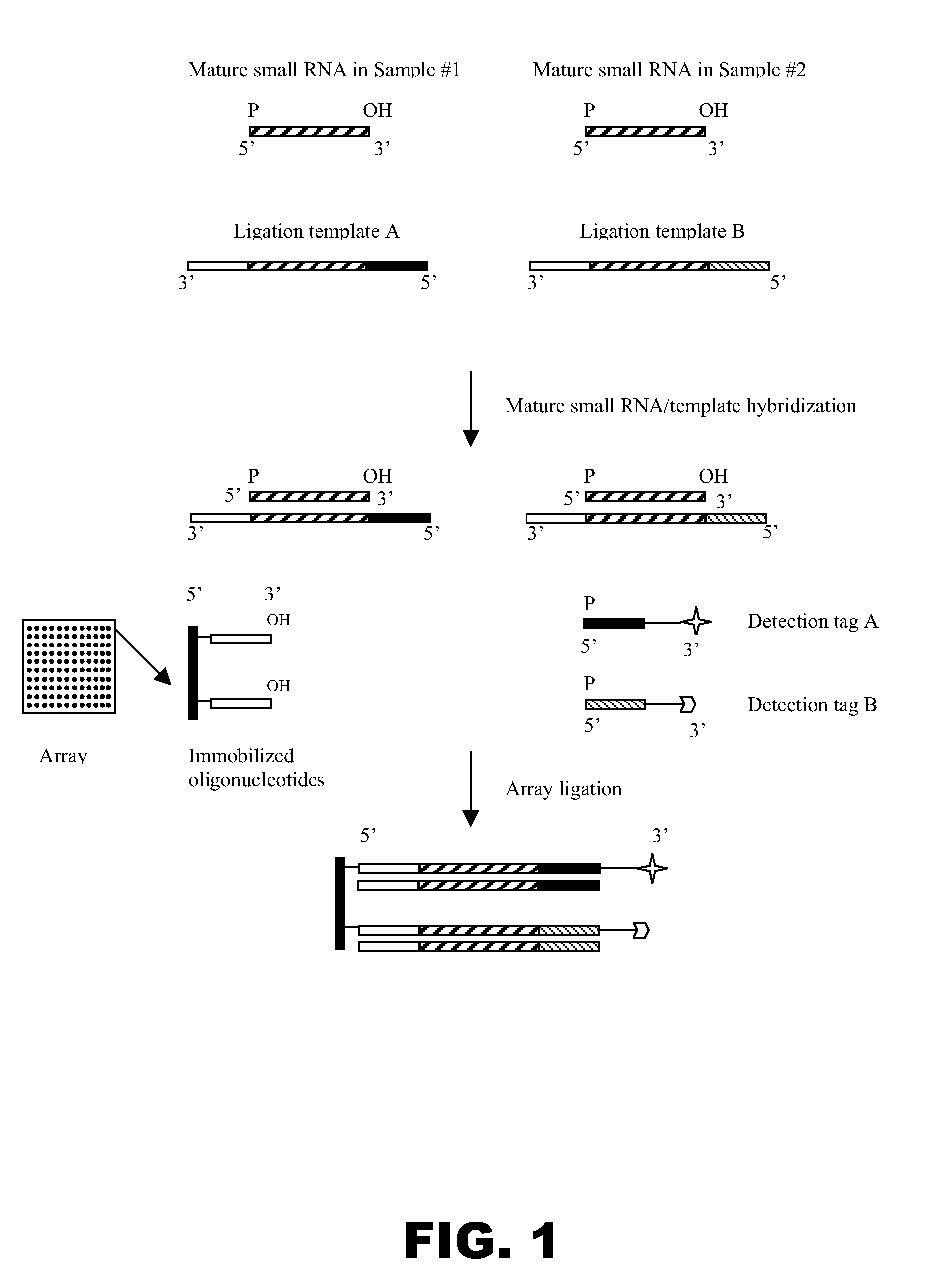Universal ligation array for analyzing gene expression or genomic variations
a technology of ligation arrays and gene expression, applied in the field of array systems, can solve the problems of only existing array systems, hybridization techniques cannot distinguish between target nucleic acids that differ by one nucleotide, and are not well suited for genomic variation analysis
- Summary
- Abstract
- Description
- Claims
- Application Information
AI Technical Summary
Benefits of technology
Problems solved by technology
Method used
Image
Examples
example 1
Array Analyses Using Immobilized Oligonucleotides with Free 3′ Hydroxyl Groups
[0133]The purpose of this experiment was to evaluate whether the 5′ terminal phosphate group of an RNA molecule may be ligated to the free 3′ hydroxyl group of an oligonucleotide immobilized on a solid support via the catalytic activity of a template-dependent ligase in the presence of a ligation template, as depicted in FIG. 1. The RNA molecules to be analyzed were human mature microRNAs, and their expression levels were analyzed in two different human cell lines.
[0134](i) Array of Immobilized Oligonucleotides
[0135]All of the oligonucleotides used in this example were synthesized by conventional techniques. Each of the oligonucleotides to be immobilized on glass slides was either 10 or 20 nucleotides in length: each comprised a unique artificial sequence of 10 nucleotides, with 50% GC content, and some further comprised an extension of 10 adenosine residues (As) at the 5′ end. Each oligonucleotide was als...
example 3
Target MicroRNA to Immobilized Oligonucleotides at a Higher Temperature Using a Thermophilic DNA Ligase
[0161]The purpose of this example was to evaluate whether a template-dependent thermophilic DNA ligase could be used for high temperature ligation of an RNA molecule to a DNA molecule immobilized on a solid support in the presence of a template DNA molecule. Homogeneous solution ligation analyses revealed that both Taq DNA ligase and 9° N DNA ligase were active in ligating the 3′-hydroxyl group of an RNA molecule to the 5′ terminal phosphate group of a DNA molecule in the presence of a template DNA molecule. It is well known that Taq DNA ligase is active between 45° C. and 65° C., and that 9° N DNA ligase is active between 45° C. and 90° C. Since the later is active at a wider range of temperatures, this ligase was used in this experiment. The ligase was tested with different lengths of base pairing between an immobilized oligonucleotide and its complementary counterpart on a ligat...
PUM
| Property | Measurement | Unit |
|---|---|---|
| size | aaaaa | aaaaa |
| size | aaaaa | aaaaa |
| size | aaaaa | aaaaa |
Abstract
Description
Claims
Application Information
 Login to View More
Login to View More - R&D
- Intellectual Property
- Life Sciences
- Materials
- Tech Scout
- Unparalleled Data Quality
- Higher Quality Content
- 60% Fewer Hallucinations
Browse by: Latest US Patents, China's latest patents, Technical Efficacy Thesaurus, Application Domain, Technology Topic, Popular Technical Reports.
© 2025 PatSnap. All rights reserved.Legal|Privacy policy|Modern Slavery Act Transparency Statement|Sitemap|About US| Contact US: help@patsnap.com



